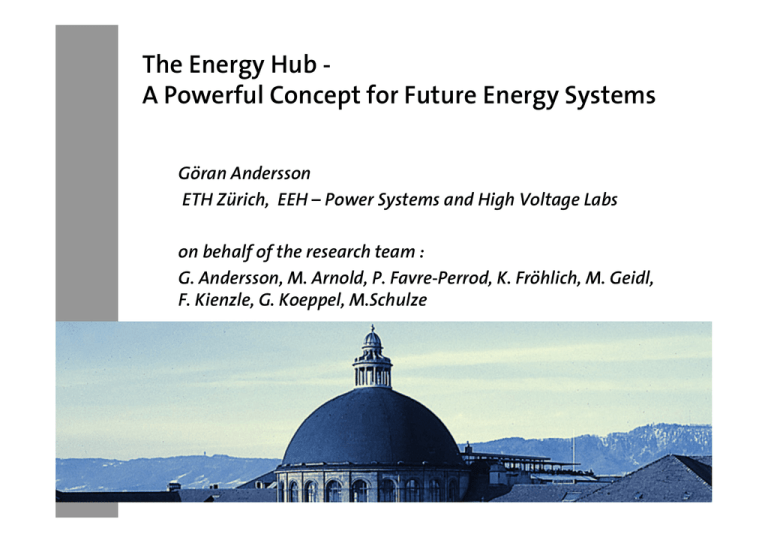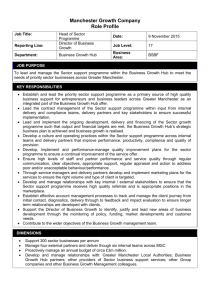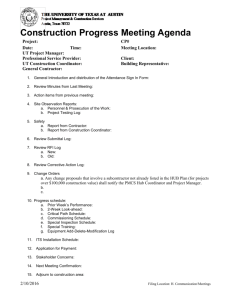The Energy Hub - A Powerful Concept for Future Energy Systems
advertisement

The Energy Hub A Powerful Concept for Future Energy Systems Göran Andersson ETH Zürich, EEH – Power Systems and High Voltage Labs on behalf of the research team : G. Andersson, M. Arnold, P. Favre-Perrod, K. Fröhlich, M. Geidl, F. Kienzle, G. Koeppel, M.Schulze Presentation outline • Project background • The hub concept • Examples • Concluding remarks 2 Visions of Future Energy Networks: Motivation • Today‘s system is necessarily not optimal to meet future requirements from customers and power producers • New technologies are emerging both with regard to primary systems and secondary and enabling systems • Environmental and regulatory requirements are changing 3 Greenfield Approach 4 Interaction System Requirements - Technology System Technology Customer req. Layout Operation - Control Optimisation Regulation ... Features Costs Requirements … 5 Project sponsors: ABB AREVA TD Siemens Bundesamt für Energie (CH) SwissPower, Novatlantis, … ETH Academic partners: TU Delft, RWTH Aachen, NTNU Trondheim, CEPE ETHZ, 6 Principle network layout – multicarrier system 7 The Energy Hub – a key element 8 The Energy Hub – an example 9 Energy Hub Model 10 The energy interconnector Approach: Common transmission device for several energy carriers chemical energy heat electricity 11 Three step procedure requirements of the (future) grid participants identification of necessary technology modelling, optimisation, analysis extrapolation, scenarios databases, ecobalancing, techn. forecasts implementation proposals P2(t) P1(t) P2(t) P3(t) Pn(t) local energy demand (chemical, thermal,electric) P1(t) P3(t) Pn(t) 12 General Results • Power conversion ⇔ price conversion Pα , ψα P Ψ=ΛC Pε , ψ ε # system marginal prices ENERGY HUB C Lα , λ α # Lζ , λζ L=CP Λ hub marginal prices 13 Comparison with classical case 14 Example for hub evaluation • Goal: optimal operation of an energy hub 27 kW optimal input = ? 50 kW 23 kW gas CHP 65 kW 76 kW • electricity heat 24 kW given loads 100 kW Given – Energy cost (electr. = 0.1 €/kWh, gas, heat = 0.05 €/kWh) – Hub characteristics ⎡1 ηge (Pg ) 0⎤ C=⎢ ⎥ 0 (P ) 1 η ⎢⎣ ⎥⎦ gt g • ECO2 = 0.7 kg / kWhgas Wanted: optimal hub inputs due to minimal energy cost 15 Operational Optimization Result 13.0 70.0 Energy cost 60.0 CO2 Emissions 12.8 50.0 12.7 40.0 12.6 30.0 Minimum at 65 kW gas input 12.5 20.0 12.4 10.0 12.3 0.0 30 40 50 60 70 80 CO 2 output in kg 12.9 Energy cost in € • 90 Gas input in kWh 16 Investment evaluation 17 Optimal Hub Coupling C=? 18 Optimal Hub Coupling 19 Example: coupling of electrical and gaseous chemical power Assumptions: electrical input power constant inlet (20 °C) and outlet (120 °C) temperature fixed inlet pressure outlet pressure Conclusion: For given electrical losses economical chemical throughput is limited within the range: 20 Reliability of an Energy Hub Exptected Energy Not Supplied: 1h/a Æ 27.6 Min/a 21 Practical Case: Regionalwerke Baden 22 Other results • Detailed reliability modeling and analysis • Optimal sizing and use of storage devices • Modeling of stochastic (non-dispatchable) power sources 23 Future homework • Expand models from steady state to dynamic, develop control strategies • Develop investment strategies (bridging systems) • Identify and evaluate necessary technology • Apply the hub idea to a Swiss city (Baden, Swiss Power) • Integrate coupling with mobility • Develop Road Maps for the European system 24 Conclusions • Sources, load and network are strongly interactive • Systems and technology aspects are strongly interactive as well Î research approach has to consider all these interactions • The hybrid network is closer to reality than it looks in a first view 25 More information http://www.eeh.ee.ethz.ch/psl/research/vofen.html 26





